Usnea Barbata, Old Man’s Beard
Usnea, Old Man’s Beard
Lichens are composite life-forms, the product of a symbiotic relationship between algae, funghi and yeast. Many of them look like plants, but they are not plants at all. Lichens can grow in almost any environment, from bare rock to arctic tundra, deserts and even toxic slag heaps. Some even grow inside rock and others spend their entire lives blowing in the wind. They survive because the algae provide food for the funghi through photosynthesis and the fungi provides filaments that protect the algae from the environment and moisture that it draws from the air. The yeasts help the lichen produce acid to defend itself from other microbes. Lichens are not parasites; where they grow on living trees they don’t harm the trees in any way, they might even provide benefits. Lichens provide food and medicine, often in the most inhospitable places and Usnea Barbata, Old Man’s Beard is one of the most useful.
Modern science likes to isolate and study the components of life, without attention to the interactions between them. As such, science has identified the ‘main compound’ behind bearded usnea’s health properties as the bitter usnic acid. Repeated studies have shown the usneas to be effective against Gram-positive bacteria, such as Bacillus subtilis, Enterococcus faecalis, Mi-crococcus viradans, Staphylococcus aureus, streptococci and mycobacterium tuberculosis, often with very low concentrations.
A wide range of symptoms and everyday illnesses are attributed to these bacteria, many of which are also considered to be ‘antibiotic resistant’. Bear in mind the etymology of ‘anti-biotic,’ which literally means against life; if you killed all the microbes in your body, you would die. We already live symbiotically with many micro-organisms, which makes a creature like lichen a very useful plant teacher, given its unique symbiotic expertise.
According to the NHS website in the UK, these diseases can be attributed to Staphylococcus aureus:
“There are many types of Staphylococci, but most infections are caused by a group called Staphylococcus aureus.
This group of bacteria includes meticillin-resistant Staphylococcus aureus (MRSA), which is resistant to certain antibiotics that are commonly used for staph infections, such as flucloxacillin.
It also includes PVL-Staphylococcus aureus, which produces a toxin called Panton-Valentine leukocidin (PVL), which kills infection-fighting white blood cells and can cause recurrent skin infections, such as boils and abscesses.
This page covers some of the main types of staph infection, including information on how these infections are spread and treated.
Types of staph infections
Staph infections can be broadly classified into two groups: skin and soft tissue infections, and invasive infections. Examples are given below.
Skin and soft tissue infections
Most infections caused by staph bacteria are relatively minor and only affect the skin or underlying tissue. Common examples include:
- boils – red, painful lumps on the skin that usually develop on the neck, face, armpit or buttocks
- impetigo – a highly contagious skin infection that mainly affects children, which can cause sores, blisters and crusts to develop on the skin
- cellulitis – an infection of the deep layers of the skin, which can cause affected areas to quickly become red, painful, swollen and hot
- a skin abscess – a collection of pus that appears as a painful lump under the surface of the skin
- folliculitis – an infection of a hair follicle (small sac in the skin that a hair grows from), which causes an itchy pus-filled bump to develop
- wound infections – an infection of a cut or graze or surgical wound, causing redness, swelling, pain and pus
- staphylococcal scalded skin syndrome (SSSS) – a more serious condition that mainly affects babies and young children, where staph bacteria release a toxin that damages the skin, leading to extensive blistering that looks like the skin has been scalded
Invasive infections
In a small number of people, a staph skin infection can lead to a more serious, invasive infection deeper within the body. Examples include:
- septic arthritis – a joint infection that causes pain, swelling, redness and tenderness in affected joint
- osteomyelitis – a bone infection, usually affecting one of the legs, causing bone pain, restricted movement, and swelling, redness and warmth in the affected are
- pneumonia – an infection of the lungs that causes persistent coughing, breathing difficulties and chest pain; this often occurs after a viral illness such as fl
- endocarditis – an infection of the inner lining of the heart, causing a fever, chest pain, coughing, weakness and shortness of breat
- sepsis – an infection of the blood that causes a high temperature (fever), rapid heartbeat and rapid breathin
- toxic shock syndrome – where bacteria release toxins into the blood, which can cause a sudden fever, vomiting, diarrhoea, fainting, dizziness, confusion and a rash.”
http://www.nhs.uk/conditions/Staphylococcal-infections/Pages/Introduction.aspx
This is what the same NHS site has to say about Streptococci infections:
“Minor strep A infections
Most infections caused by strep A are unpleasant, but don’t pose a serious threat to your health. These include:
- throat infections (pharyngitis or “strep throat”) and tonsillitis – which can cause a sore throat, swollen glands and discomfort when swallowing
- impetigo – a skin infection that can cause sores, blisters and crusts to develop on the skin
- cellulitis – an infection of the deeper layers of the skin, which can cause affected areas to quickly become red, painful, swollen and hot
- a middle ear infection – which often causes earache, a high temperature (fever) and some temporary hearing loss
- sinusitis – an infection of the small cavities behind the forehead and cheekbones, which causes a blocked or runny nose and a throbbing pain in your face
- scarlet fever – an infection that causes a widespread, fine pink-red rash that feels like sandpaper to touch
Invasive strep A infections
In rare cases, strep A bacteria can penetrate deeper inside the tissues and organs of the body, and become what’s known as an invasive infection.
These infections are much rarer and usually affect certain groups of people, including babies, elderly people, people with diabetes, and people with weak immune systems (for example, because of cancer treatment or HIV).
Examples of invasive infections include:
- pneumonia – an infection of the lungs that causes persistent coughing, breathing difficulties and chest pain
- sepsis – an infection of the blood that causes a fever, rapid heartbeat and rapid breathing
- meningitis – an infection of the protective outer layer of the brain that causes a severe headache, vomiting, stiff neck, sensitivity to light and a distinctive blotchy red rash
- toxic shock syndrome – where bacteria release toxins into the blood, which can cause a sudden high fever, nausea and vomiting, diarrhoea, fainting, dizziness and confusion
- necrotising fasciitis – an infection of the deeper layers of the skin, fat and covering of the muscle (fascia), which can cause severe pain, swelling and redness of the affected area that can spread very quickly
Group B strep
Group B strep (strep B) usually live harmlessly inside the digestive system and in the vagina.
Strep B can sometimes cause urinary tract infections (UTIs), skin infections, bone infections, blood infections and pneumonia, particularly in vulnerable people, such as the elderly and those with diabetes.”
http://www.nhs.uk/conditions/streptococcal-infections/pages/introduction.aspx.
Streptococci and Staphylococci commonly live on the skin of humans and other animals. They are not usually problematic, but they are opportunistic and like to get into open wounds where they can cause problems, especially for a weakened or poorly trained immune system. They are highly infectious, from human to human and between humans and other animals. I hold the view that exposure to these kind of bacteria are useful to a healthy individual, training the immune system and keeping the local bacterial colony in check.
I’m not going to go into detail regarding all the bacteria that usnea is effective against, it is generally regarded as effective against most gram-positive bacteria. Its effectiveness in strep and staph infections is sufficient for it to hold its place in Panacea’s chest. And it grows locally.
I first noticed Old Man’s Beard on the edge of the clearing where I do special cordings, a place of power. I didn’t know what it was at first, receding shyly amongst the Stag’s Antler Lichens on the oak trees. It has a slightly more yellow hue than the Stag’s Antler (Evernia Prunastri) and has beard-like tufted fibres that are rounded, as opposed to the flattened lobes of the Stag’s Antler, that is also known as Oak Moss. I usually notice plants and minerals only at the exact time I need them, but I didn’t have any specific need for usnea when it called my attention. After I looked it up and realised just how useful it is, I went and harvested some to make a tincture. I’ve used it many times since then and consider it to be one of the most useful tinctures to have to hand.
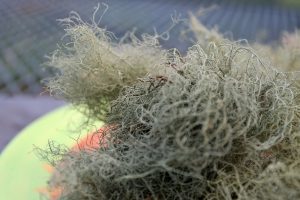
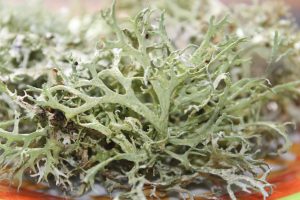
How I’ve used usnea:
Usnea for infected wounds
Recently, Freya gashed her leg quite badly one evening. Overnight, she managed to turn a nasty gash into a gaping wound, so we decided to take her to the vets to get stitched up. The position of the wound put a huge strain on the stitches and by the next day she’d ripped several out, leaving a nice little pocket for bacteria to colonize. The wound got infected and began to smell, so I cleaned it and dosed her with Usnea Barbata tincture, internally and directly on the wound. By the next day the infection had cleared and she’d managed to rip the rest of the stitches out, leaving an open but clean wound.
I don’t have any photos of when she first did it, or the infected stage, but this is the wound six days after she did it, after the infection was cleared and she had begun healing. This is the wound 10 days later. We have been treating it with yarrow in coconut oil to keep it clean and stimulate healing.
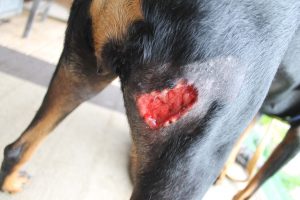
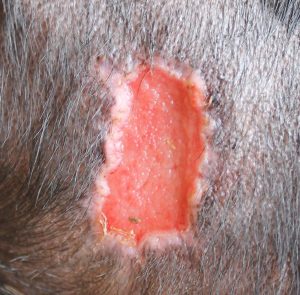
Usnea for cystitis
A visitor here felt cystitis coming on, so I gave her Usnea Barbata tincture to take in a glass of water every hour. Within three hours the symptoms had reduced, but she had to leave and I didn’t have enough tincture to give her. I’m fairly sure that the tincture would have resolved the problem if she had been able to continue taking it.
Strep and staph are often involved in cystitis, along with other bacteria. Correcting the strep and staph imbalance can provide a sufficient boost, so that the immune system can take care of the rest.
(I’ve since found that Usnea combined with Apple Cider Vinegar and Berberis Homaccord is a good cystitis remedy, if caught early enough.)
Usnea for sore throat
Streptococcus bacteria cause many throat infections. Infections often occur when seasons change, or when groups of people get together. I got strep throat around the autumn equinox and there are four of us here right now. I took usnea tincture when the symptoms first appeared like a rasping in the back of my throat and it cleared up the next day. A few days later it came back causing swollen glands in my neck. Once again I took usnea tincture, s a dropper full three times a day and it cleared up within 24 hours.
Preparation of usnea tincture
My preferred method is to dry the clumps of Old Man’s Beard, in a dehydrator or naturally, then grind it up in a coffee grinder till it forms a fine powder. I then simmer it gently in alcohol for 20 minutes, I use local orujo, let it cool and simmer it again. Once it’s cooled the second time I put the whole lot in a jar and leave it to steep for a week or so.
Don’t over cook it! It needs to be a bright green to be active. Store in a cool dark place.
I’ve tried it without grinding and the resulting tincture lacks the green colour of the powdered version and doesn’t taste so much of the lichen

Windows and Doors
Transmutation and Energy
You May Also Like
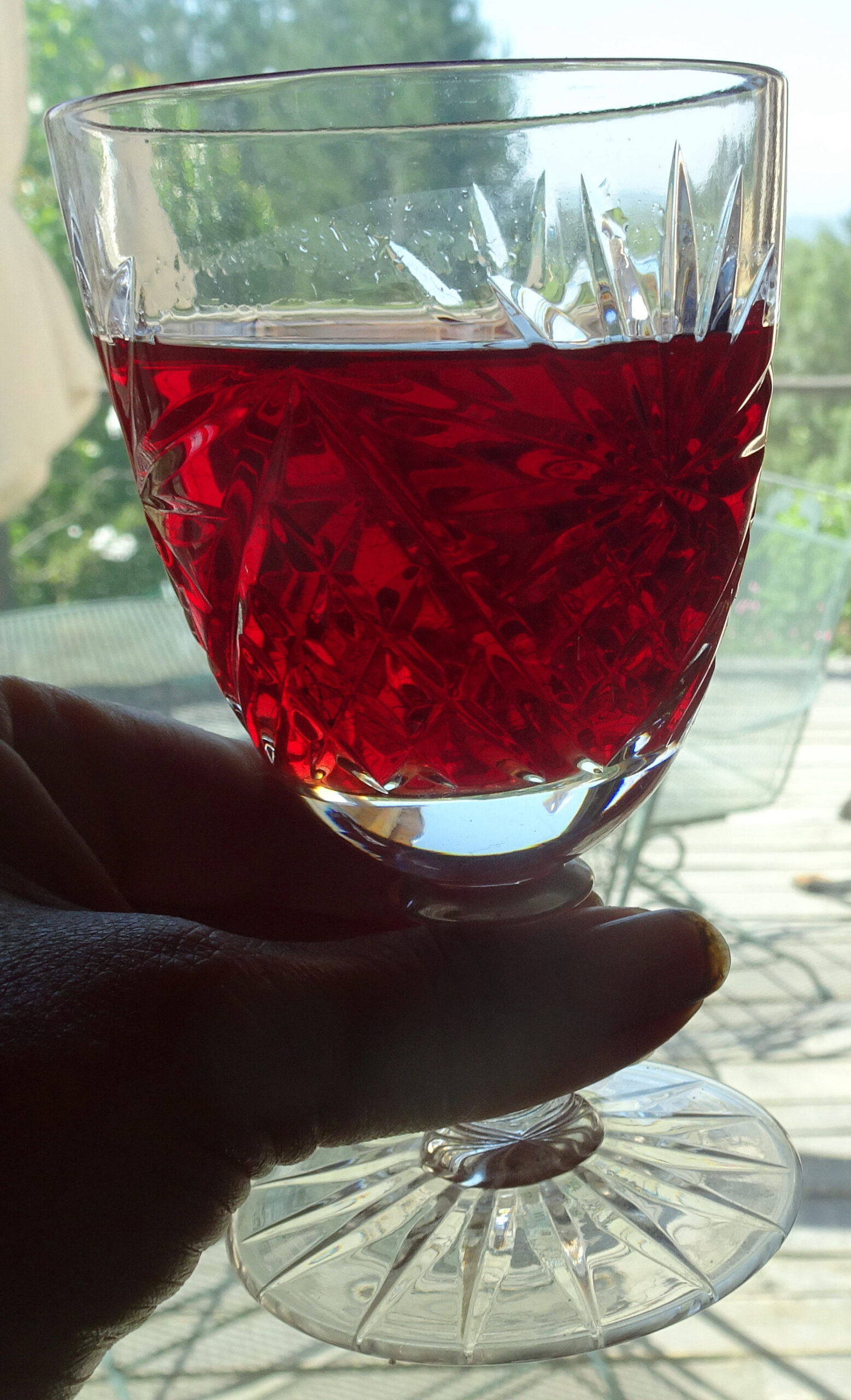
St John’s Wort: Blood from the Sun
August 4, 2021
Yellow dock root: badger medicine for a new story
April 26, 2019
